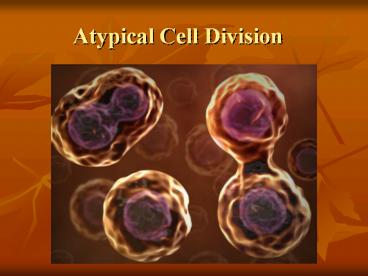Atypical Cell Division - PowerPoint PPT Presentation
Title:
Atypical Cell Division
Description:
Klinefelters syndrome is another example of too many chromosomes. The child inherits two X chromosomes and a Y chromosome. The child is a male, ... – PowerPoint PPT presentation
Number of Views:73
Avg rating:3.0/5.0
Title: Atypical Cell Division
1
Atypical Cell Division
2
- Sometimes, body processes can go wrong. One of
these processes is cell division. - When something goes wrong with a somatic cell,
there are millions of other cells in the same
place so it often causes no noticeable effect.
3
- When something goes wrong with a reproductive
cell, however, it is more trouble. - If that sperm or egg with a problem results in an
embryo all of the cells will be affected.
4
- Nondisjunction is a failure to separate that can
occur between two homologous chromosomes during
meiosis. - As a result, one of the daughter cells is missing
a chromosome, and the other has an extra
chromosome. These cells will not function
properly.
5
- If the cell with the extra chromosome develops,
one of the problems is Down syndrome. - People with Down syndrome have an extra
chromosome on pair 21. This usually results in a
mental disability, though there are a wide range
of possibilities.
6
- Klinefelters syndrome is another example of too
many chromosomes. The child inherits two X
chromosomes and a Y chromosome. - The child is a male, but has high levels of
estrogen. They do not develop sperm and cannot
father children.
7
- An example of a disorder caused by not enough
chromosomes is Turners syndrome. - Turner syndrome occurs when a female baby has
only one X chromosome. These females do not
mature sexually and are shorter in height.
8
Karyotyping
- A karyotype is a picture of the chromosomes from
a cell, arranged in homologous or similar pairs. - The chart is organized from the largest pair (1)
to the shortest pair (22). - Pair 23 are the sex chromosomes. Remember that
because a male has mismatched sex chromosomes
that will be the only time the two chromosomes
dont look exactly the same.































